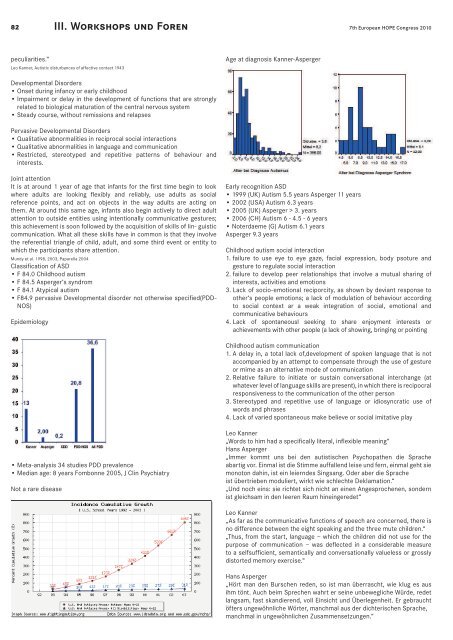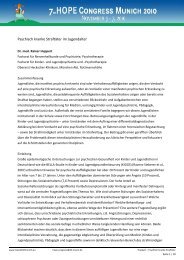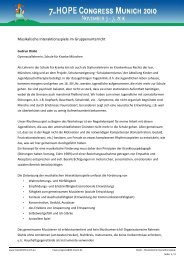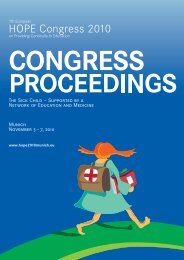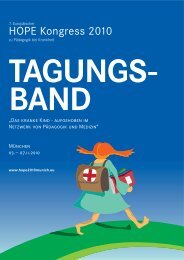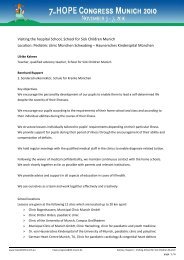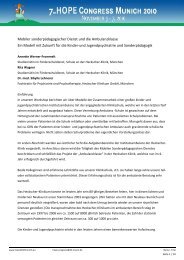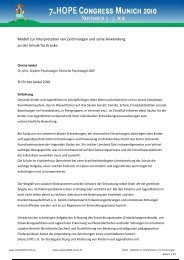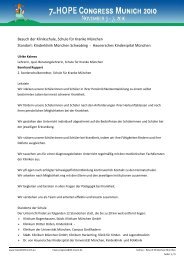RZ HOPE Tagungsband.indd - Hope Congress Munich 2010
RZ HOPE Tagungsband.indd - Hope Congress Munich 2010
RZ HOPE Tagungsband.indd - Hope Congress Munich 2010
Sie wollen auch ein ePaper? Erhöhen Sie die Reichweite Ihrer Titel.
YUMPU macht aus Druck-PDFs automatisch weboptimierte ePaper, die Google liebt.
82 7th European <strong>HOPE</strong> <strong>Congress</strong> <strong>2010</strong> 7th European <strong>HOPE</strong> <strong>Congress</strong> <strong>2010</strong><br />
83<br />
peculiarities.“<br />
Leo Kanner, Autistic disturbances of affective contact 1943<br />
Developmental Disorders<br />
• Onset during infancy or early childhood<br />
• Impairment or delay in the development of functions that are strongly<br />
related to biological maturation of the central nervous system<br />
• Steady course, without remissions and relapses<br />
Pervasive Developmental Disorders<br />
• Qualitative abnormalities in reciprocal social interactions<br />
• Qualitative abnormalities in language and communication<br />
• Restricted, stereotyped and repetitive patterns of behaviour and<br />
interests.<br />
Joint attention<br />
It is at around 1 year of age that infants for the fi rst time begin to look<br />
where adults are looking fl exibly and reliably, use adults as social<br />
reference points, and act on objects in the way adults are acting on<br />
them. At around this same age, infants also begin actively to direct adult<br />
attention to outside entities using intentionally communicative gestures;<br />
this achievement is soon followed by the acquisition of skills of lin- guistic<br />
communication. What all these skills have in common is that they involve<br />
the referential triangle of child, adult, and some third event or entity to<br />
which the participants share attention.<br />
Mundy et al. 1998, 2003, Paparella 2004<br />
Classifi cation of ASD<br />
• F 84.0 Childhood autism<br />
• F 84.5 Asperger‘s syndrom<br />
• F 84.1 Atypical autism<br />
• F84.9 pervasive Developmental disorder not otherwise specifi ed(PDD-<br />
NOS)<br />
Epidemiology<br />
• Meta-analysis 34 studies PDD prevalence<br />
• Median age: 8 years Fombonne 2005, J Clin Psychiatry<br />
Not a rare disease<br />
III. Workshops und Foren III. Workshops und Foren<br />
Age at diagnosis Kanner-Asperger<br />
Early recognition ASD<br />
• 1999 (UK) Autism 5.5 years Asperger 11 years<br />
• 2002 (USA) Autism 6.3 years<br />
• 2005 (UK) Asperger > 3. years<br />
• 2006 (CH) Autism 6 - 4.5 - 6 years<br />
• Noterdaeme (G) Autism 6.1 years<br />
Asperger 9.3 years<br />
Childhood autism social interaction<br />
1. failure to use eye to eye gaze, facial expression, body psoture and<br />
gesture to regulate social interaction<br />
2. failure to develop peer relationships that involve a mutual sharing of<br />
interests, activities and emotions<br />
3. Lack of socio-emotional reciporcity, as shown by deviant response to<br />
other‘s people emotions; a lack of modulation of behaviour according<br />
to social context ar a weak integration of social, emotional and<br />
communicative behaviours<br />
4. Lack of spontaneousl seeking to share enjoyment interests or<br />
achievements with other people (a lack of showing, bringing or pointing<br />
Childhood autism communication<br />
1. A delay in, a total lack of,development of spoken language that is not<br />
accompanied by an attempt to compensate through the use of gesture<br />
or mime as an alternative mode of communication<br />
2. Relative failure to initiate or sustain conversational interchange (at<br />
whatever level of language skills are present), in which there is recipocral<br />
responsiveness to the communication of the other person<br />
3. Stereotyped and repetitive use of language or idiosyncratic use of<br />
words and phrases<br />
4. Lack of varied spontaneous make believe or social imitative play<br />
Leo Kanner<br />
„Words to him had a specifi cally literal, infl exible meaning“<br />
Hans Asperger<br />
„Immer kommt uns bei den autistischen Psychopathen die Sprache<br />
abartig vor. Einmal ist die Stimme auffallend leise und fern, einmal geht sie<br />
monoton dahin, ist ein leierndes Singsang. Oder aber die Sprache<br />
ist übertrieben moduliert, wirkt wie schlechte Deklamation.“<br />
„Und noch eins: sie richtet sich nicht an einen Angesprochenen, sondern<br />
ist gleichsam in den leeren Raum hineingeredet“<br />
Leo Kanner<br />
„As far as the communicative functions of speech are concerned, there is<br />
no difference between the eight speaking and the three mute children.“<br />
„Thus, from the start, language – which the children did not use for the<br />
purpose of communication – was defl ected in a considerable measure<br />
to a selfsuffi cient, semantically and conversationally valueless or grossly<br />
distorted memory exercise.“<br />
Hans Asperger<br />
„Hört man den Burschen reden, so ist man überrascht, wie klug es aus<br />
ihm tönt. Auch beim Sprechen wahrt er seine unbewegliche Würde, redet<br />
langsam, fast skandierend, voll Einsicht und Überlegenheit. Er gebraucht<br />
öfters ungewöhnliche Wörter, manchmal aus der dichterischen Sprache,<br />
manchmal in ungewöhnlichen Zusammensetzungen.“<br />
Childhood autism RRB<br />
1. An encompassing preoccupation with one or more stereotyped and<br />
restricted patterns of interest that are abnormal in content or focus;<br />
or one or more interests that are abnormal in their intensity and<br />
circumscribed nature, though not in their content or focus<br />
2. Apparently compulsive adherence to specifi c, non -functional routines<br />
or rituals<br />
3. Stereotped and repetitive motor mannerisms that involve either hand or<br />
fi nger fl apping or twisting, or complex whole-body movements<br />
4. Preoccupations with part-objects or non-functional elements of play<br />
materials (such as odour, the feel of their surfaces, or the noise or<br />
vibration that they generate.<br />
Course<br />
Age at diagnosis: 7 years<br />
Age at FU: 29 years<br />
IQ >50<br />
IMPAIRMENT<br />
• SELF SUPPORT<br />
• OCCUPATION<br />
• FRIENDSHIP<br />
• PARTNER<br />
Howlin, Goode, Hutton, Rutter 2004 J Child Psychology and Psychiatry<br />
Psychopathologie CBCL<br />
ADHS<br />
• Aufmerksamkeitsdefi zit<br />
- Hyperaktivitätsstörung (DSM-IV)<br />
- Unaufmerksamer Subtyp<br />
- Hyperaktiv-impulsiver Subtyp<br />
- Kombinierter Subtyp<br />
• 3-Monats-Prävalenz aller Subtypen: 28% (Simonoff et al., 2008)<br />
– 10-14 Jahre alt; populationsbasiert; N=255<br />
• Punktprävalenz aller Subtypen: 30% (Leyfer et al.,2006)<br />
– 5-17 Jahre alt; Klinikstichprobe; N=109<br />
– Unaufmerksamer Subtyp: 20%<br />
ADHS<br />
• Methylphenidat – Evidenzgrad II (RUPP 2005; Posey et al., 2007; Jahromi et al., 2009)<br />
– N=72, 5-14 Jahre; ASD + Hyperaktivität; „mittlere“ Dosis = 0,25 mg/kg<br />
KG am besten, 3x täglich<br />
• Dtl. Verbesserung der Hyperaktivität<br />
• Aber: geringerer Effekt bei ADHS<br />
• 49% Responder; 18% Abbruchrate wg. Nebenwirkungen<br />
• NW: Appetitminderung, Schlafprobleme, gesteigerte Irritabilität<br />
– N=66 (Subgruppe)<br />
• Besserer Effekt auf Hyperaktivität/Impulsivität als auf Unaufmerksamkeit;<br />
hier Dosierung bis 0,5 mg/kg KG<br />
– N=33 (Subgruppe)<br />
• Verbesserung der gemeinsamen Aufmerksamkeit, der Selbstregulation<br />
und der affektiven Regulation<br />
Angst- und Zwangsstörungen<br />
• Häufi ge Komorbidität bei ASD (Leyfer et al., 2006; Simonoff et al., 2008)<br />
– Zwangsstörungen: ca. 35%<br />
• DD: Zwangsstörung – stereotypes Verhalten<br />
– Angststörungen: insbes. Spezifi sche Phobien; zusammen ca. 45%<br />
• Medikation<br />
– CY-BOCS: Risperidon – Evidenzgrad I (Cochrane review Jesner et al., 2007)<br />
– SSRI: Citalopram, Fluoxetin untersucht<br />
• Kein (!) Effekt auf stereotypes und zwängliches Verhalten<br />
• Steigerung (!) der „Irritabilität“ (King et al. 2009; Hollander et al., 2005)<br />
• Bei HFA/Asperger-Syndrom<br />
– Kognitive Verhaltenstherapie bei Angststörungen (Evidenzgrad II)<br />
(Sofronoff et al., 2005; Wood et al., 2009)<br />
Zwangsstörungen Symptome<br />
• Zwangshandlungen waschen, kontrollieren, wiederholen, ordnen, oft in<br />
Form von komplexen Zwangsritualen.<br />
• Zwangsgedanken umschriebene Befürchtungen (vor Krankheit oder Tod,<br />
Urin, Kot und anderen ekelbesetzten Stoffen, Schmutz, Chemikalien,<br />
Bakterien).<br />
• Fragezwänge, Zwangsfl uchen und Zwangsschimpfen.<br />
Depressive Episoden<br />
• Komorbidität bei HFA/Asperger-Syndrom im Jugend und Erwachsenenalter<br />
(Leyfer et al., 2006; Simonoff et al., 2008; Sierlin et al., 2008)<br />
• Medikation<br />
– Evidenzgrad III


